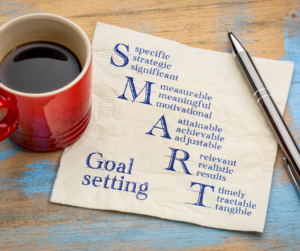A couple months ago, I decided to begin something I have been putting off for a long time. I started a workout journey! I was noticeably drained both physically and mentally, so I decided it was time to make a change. For the last month or so, one of the ways I have been moving my body has been with online yoga, and I have been loving it so far. Not only do I feel stronger both physically and mentally than I have in a long time, I’ve realized the lessons I learn in yoga class can also be implemented directly into my work as a marketing and public relations professional. Keep reading to discover six connections I made that may help you on your next marketing campaign!
A Brief Yoga History
Before we connect yoga with marketing, let’s create a base knowledge of the history of yoga and all it encompasses, because there are some common misconceptions about the practice.
Yoga is an ancient and complex practice rooted in Indian philosophy. The origins of yoga can be traced to Northern India over 5,000 years ago. The word “yoga” was first mentioned in ancient Sanskrit texts called the Rig Veda. After this, yoga was refined and developed by Rishis (sages) who documented their practices into Upanishads – a work containing over 200 scriptures. The language of yoga is Sanskrit, which is the root of many Indian languages, and one of the oldest languages in the world. “Yoga” comes from the Sanskrit word “yuj,” which means “union” or “to join.” To learn more about the history of yoga and some important contributors to the practice, check out this resource about the world’s first yoga museum.
Modern yoga became popular in Western culture through the 1970s. When people think of modern yoga, they might think of just the physical aspect of yoga or the postures, but yoga can also be a lifestyle. It brings together elements of breathwork, flexibility and strength to improve and exercise mental and physical well-being. Yoga is all about connecting the mind, body and spirit to be one cohesive unit.
There is also not just one way to do yoga. It is believed there are around 19 types of yoga and over 66 postures. This article covers 11 of the most common types. Yoga also has many proven health benefits including improving sleep, building muscle strength and enhancing flexibility.
Now that we know more about yoga and where it comes from, what does it have to do with marketing?
Six Connections Between Yoga And Content Marketing
1.) Set A Goal Or Intention
Setting a goal or intention each time you step onto your mat is a key element of yoga. Intention setting brings together the physical aspect of the exercise and a mental aspect to deepen your practice. In other words, practitioners experience more benefits from their exercises by deciding what they will focus on.
Yoga Hub recommends focusing on your breath and letting the rest of the world melt away as you think about a virtue you would like to embody. They also recommend trying to keep the wording positive, like “I will be grateful for my body,” instead of “I won’t take my body for granted.” When things get challenging throughout the practice, you can think back on that intention, or goal, to ground you.
In marketing, goals are also an essential part of your strategy and often the place to start when developing a campaign. Goal setting in marketing sets the direction for your strategy. It helps establish the steps you will need to take. Some example goals include:
- Growing your social media audience to 10,000 followers by the end of 2024.
- Increasing your e-newsletter audience by 500 by June.
- Climbing to the top five search results in your industry niche by May.
Without a set goal (or goals) before you begin your campaign work, it will be hard to know what to do next, and on the flipside, when the marketing campaign concludes you will have no way to measure if you were successful or not.
While goals are the foundation of your marketing strategy, they can – and should – evolve as your audience, business and the world change. At Three Girls Media, we utilize a SMART goal framework to ensure each goal is specific, measurable, attainable, relevant and timebound.
2.) Build A Solid Foundation
After goal setting, in most yoga classes or practices your next step will include establishing your foundation. This includes the pose your body is in and your mindset going into your yoga session. To ground yourself in that foundation, instructors advise practitioners to feel the part of their body that is touching the earth. In yoga, just about any part of the body can be a grounding foundation depending on the pose. By bringing your awareness and focus to this foundation of your yoga practice, you can find balance in any yoga stance.
The same is true for your marketing campaign. Even though it is constantly evolving, if you remember who your brand is at its foundation, you can pivot your approach from a place that aligns with your organization. Stay true to your brand’s values, and the rest will come to fruition. When things get challenging, take a minute to breathe and ground yourself.
Another way to look at the importance of grounding in marketing is to focus on building the base and structure of your campaign before worrying about the details. In yoga, you need to learn the basic poses before doing the difficult ones or you are likely to be unsuccessful. The exact same is true in your marketing campaign. If you build a solid and strong foundation, the details will follow, and you will be much more likely to achieve your goals.
3.) Avoid Comparison – Content Marketing Isn’t Not One-Size-Fits-All!
One of my favorite parts of yoga practice is how inclusive and adaptable it is. Before each pose, the instructor will often give three options to choose from to make the pose feel right: one for people still learning, one for mid-level abilities and one for more advanced students. They will also clarify that everyone’s body can feel different on any given day, so if you choose a higher level today but feel better at a lower one tomorrow, that is okay. Your body may also need something entirely different than those three options, and that is okay too! Do what you need at that moment. Some instructors will even suggest avoiding mirrors or closing your eyes to remove comparison from the equation. Everyone’s bodies look completely different in each pose, so it is helpful to not compare yourself to others. Think about how your body is feeling, not how it looks in the pose.

Try to avoid comparison in your marketing campaign. Just like in yoga, everyone is different and has unique needs.
Like our other yoga takeaways thus far, this lesson is one that can be helpful in all aspects of life and translates directly into your next marketing campaign. Look at every campaign with fresh eyes. What has worked well for your company one year may not be the best approach next year. As social media platforms change and the marketing environment shifts, your strategies and goals will probably change too. While it can be a useful tactic to look at other campaigns and businesses for marketing inspiration, it is important to remember not to compare yourself or your company to others. Take a lesson from the yogis on this one and be intentional about how you can better your own company’s strategy, how your campaign is performing and what you can do to improve.
4.) Be Patient For Results
Consistency is crucial to ensuring you have positive results both in marketing and in your yoga practice. If you go into your first yoga class determined to do every pose perfectly right from the get-go, you would likely be disappointed, and would get less out of your practice than if you started slowly and with intention. Results take time, and you need to practice, practice, practice to see them. If you keep learning and incorporate some of our earlier steps like setting strong goals and building a solid foundation, you will start to see the results you are hoping for. It can sometimes take months to start seeing changes — both mental and physical.
When you implement a new marketing strategy, you also may not see visible results for months. It can be difficult to trust the process and can sometimes feel discouraging. The average time to see results in a marketing campaign is six to nine months after you begin. While it can be tempting to give up or to switch up your strategy, consistency is vital to the success of your campaign. When you are feeling that temptation to give up, think from the perspective of your audience. They are not going to want to buy or support a brand they know nothing about, and it takes time to gain that rapport with potential consumers.
Consistency is not only important in how often you post, but also in the actual content that you produce. While you want to adapt your brand voice slightly depending on the platform you are posting to, you need to have a consistent, recognizable brand image so that your audience isn’t confused about who you are and what you represent. Seventy-one percent of consumers say they’re more likely to buy a product or service from a brand they recognize. If a customer was choosing between two products, one from a brand they recognized and one from a brand they had never heard of or seen before, they’re probably going to go with the brand they know.
5.) There Is Always Something New To Learn
Something I really enjoy about both marketing and yoga is that there is always something new to learn. In both fields, once you set the foundation and continue to grow in your practice, the possibilities are endless. In yoga, there are always new positions to build upon, new styles to try out and new mindsets to implement. No matter how many years of yoga you have under your belt, you still have more to learn and discover.
The exact same is true of marketing. Even if you are a seasoned expert, there is always learning to be done. Technology, like generative media, is always changing, so there is room to grow in that sector for any marketer or business owner. Over time, your audience will evolve, too. Marketing is a constantly changing field, and to remain successful, you need to grow with it. Stay on top of the latest trends in your industry to make the most out of your strategy.
6.) Have Fun During The Process
Last, but not least, have fun. Many turn to yoga not only because it is great for your body and mind, but also because they genuinely enjoy the practice. One of the things that was the hardest for me with sticking to a workout routine was that I didn’t genuinely enjoy any of the workouts I was trying. I would just stare at the clock and hope for it to be over. Yoga is a practice that I, and many others, find enjoyable. It is more of a lifestyle than other workouts that are just about the exercise.
Hopefully, you can find some enjoyment and fulfillment while planning and implementing your marketing strategy. Most likely, you are passionate about your organization and want to do anything and everything you can to help make it successful. While strategies and implementation are important, do not forget to have fun along the way. Depending on your field, engaging content can be an effective way to bring awareness to your brand.
One way to bring an element of levity to your marketing campaign is to use memes. If successful, a meme can be a great way to go viral. Your brand’s voice and personality are other ways to bring joy into your marketing campaign. There is so much competition out there these days, and being personable and relatable will encourage people to choose your brand.
Still Need Marketing Help? Contact Us At Three Girls Media
Do you need help with your marketing strategy? Our team of experienced marketers can help! We offer a complimentary 30-minute, no-obligation consultation with our CEO, Erika Taylor Montgomery! Contact us to learn more about how we can help you achieve your marketing goals.
Special Offer:
Sign up for a complimentary consultation during January and receive an Email Marketing Guide valued at $475! We offer a 30-minute phone consultation with our CEO and can answer your questions and discuss your specific marketing needs – no strings attached. Call 360-955-1410 or contact us today to arrange your consultation!



